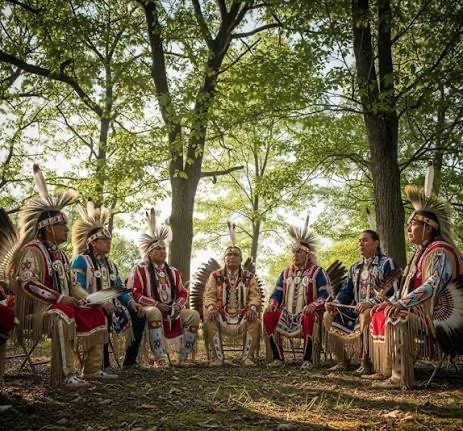An intimate look at the Native American history of our town and the wider region
Hancock sits in a landscape shaped for millennia by rivers, valleys, and seasonal migration routes. Long before Euro-American settlement and the arrival of railroads, the place we now call Hancock was part of a living network of Indigenous communities who hunted, farmed, traded, and gathered along the Delaware River.
This article summarizes what local histories and scholarly sources tell us about those deep roots, explains the meaning of historic place-names such as Chehocton, discusses the significance of Point Mountain and the river confluence, and places Hancock in the larger context of Indigenous political life — often described as the League of Nations (the Haudenosaunee confederacy) or the Five/Six Nations.
A place of meeting: Chehocton and the rivers
Local 19th-century histories and place-name records report that Hancock was historically known as Chehocton (also spelled variously Chehocton or Shehawken), a name early sources associate with the “mouth of the stream” or the “wedding of waters” — a fitting label for the town at the confluence of the East and West Branches of the Delaware River.
That confluence has made the site a natural travel node and seasonal gathering place for many Indigenous peoples for centuries. These place-name notes appear in local histories compiled in the 19th and early 20th centuries and continue to be cited by town historical resources.
Rivers like the Delaware were highways: they provided fish and other food resources, routes for canoe travel and trade, and predictable seasonal camps. Archaeological investigations in the Upper Delaware region have uncovered evidence of long-term Indigenous presence in the broader river valley, including sites with deep time depth going back thousands of years. These investigations reinforce that Hancock’s riverbanks were part of long-standing patterns of Indigenous land use.
Point Mountain: geography that shaped culture and travel
Point Mountain rises above Hancock and forms a dramatic backdrop at the river confluence. Because of its prominence, proximity to the water, and commanding views, Point Mountain and the surrounding ridgelines were strategic and meaningful in pre-contact and early historic times for travel, observation, and resource use.
Local records note Point Mountain as a recognizable geographic feature in town history; modern parks and scenic guides likewise point to its significance for both recreation and the town’s identity. Today, the mountain and the river remain central features that echo Hancock’s Indigenous past.
Who lived here historically: Lenape and neighboring peoples
The people most associated with the Delaware River valley in colonial and pre-colonial sources are the Lenape (also called Delaware). The Lenape were an Algonquian-speaking people whose historic territory ranged across what is now New Jersey, southeastern New York, eastern Pennsylvania, and parts of Delaware. Within that larger region, multiple bands and family groups used rivers, wetlands, and upland hunting grounds seasonally; they also maintained trade and social ties with neighboring nations.
In upper New York and nearby regions, Haudenosaunee (Iroquoian-speaking) peoples — including Mohawk, Oneida, Onondaga, Cayuga, and Seneca, with the Tuscarora joining later — formed a powerful political confederacy often referred to in English as the League of Five Nations (and later the Six Nations). The Haudenosaunee and Lenape were distinct peoples with distinct languages and political structures, but their territories, trade networks, and seasonal movements overlapped and interacted for centuries.
The “League of Nations”: what that term means here
When people refer to a “league” of nations in this region, they are most often pointing to the Haudenosaunee Confederacy — a political and cultural alliance governed by the Great Law of Peace and made up originally of five nations (Mohawk, Oneida, Onondaga, Cayuga, Seneca) and later the Tuscarora, forming six.
The confederacy has been admired for its sophisticated governance, decision-making processes, and diplomatic reach across northeastern North America. While the Haudenosaunee heartland is generally to the west and north of Hancock (in what is today central and western New York), their influence, diplomacy, and interactions with Algonquian neighbors (like the Lenape) were part of the region’s historical landscape.
Displacement, removal, and continuity
Like many places in the Northeast, Hancock’s Indigenous histories include episodes of dispossession, displacement, and forced migration that accelerated after European colonization. Colonial land pressures, treaties (often contested), warfare, disease, and later federal removal policies changed where Indigenous peoples lived.
Some descendants of local nations were relocated far from their original homelands; others adapted and remained in the region in smaller numbers. Yet continuities remain: cultural survival, basketry, place-names, stories, and relationships to the land endure among Lenape, Haudenosaunee, and other Indigenous communities. Archaeological and historical work helps us recover these histories, but the best sources about ongoing culture and meaning are the Indigenous communities themselves.
Why these histories matter for Hancock today
Understanding Hancock as Chehocton — a “place of joining” — can reshape how residents and visitors see the town: not simply as a 19th-century railroad or resort village, but as a landscape with millennia of human history. Recognizing Indigenous place-names, stories, and the layered past of Point Mountain and the Delaware confluence invites deeper stewardship of local resources, more inclusive public history, and respectful collaboration with descendant communities.
Where to learn more (starter links)
- Town of Hancock — local history and picture galleries (town resources that reference Chehocton and Point Mountain).
- Delaware County Historical Association (Delhi, NY) — https://www.dcha‑ny.org/
- Equinunk Historical Society (Equinunk, PA) — https://www.equinunkhistory.com/
- Cochecton Preservation Society (Cochecton, NY) — https://cochectonpreservationsociety.com/
- Regional archaeological summaries and recent investigations in the Upper Delaware River basin (for archaeological context).
- Haudenosaunee Confederacy (overview and resources on the League of Nations / Six Nations).
- Lenape/Delaware historical overviews (regional cultural and historical background).

